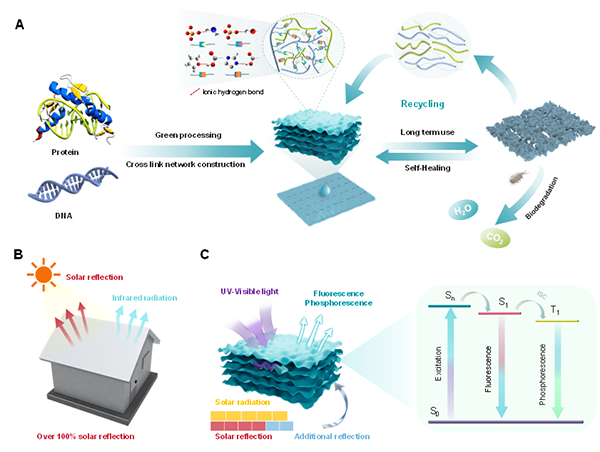
Figure. Schematic diagram of intrinsically photoluminescent biomass radiative cooling aerogel planks
Supported by the National Natural Science Foundation of China (Grant No. 52122302), Professor Hai-Bo Zhao, a member of Academician Yu-Zhong Wang’s team at Sichuan University, has introduced a novel strategy for radiative cooling leveraging the intrinsic photoluminescence properties of biomass. The team developed an all-biomass radiative cooling aerogel with high solar reflectance, scalability, exceptional flame retardancy, and recyclability, significantly improving the material’s cooling efficiency and environmental safety. The research was titled “A photoluminescent hydrogen-bonded biomass aerogel for sustainable radiative cooling” and published in Science on July 5, 2024.
The link to the paper is: http://www.science.org/doi/10.1126/science.adn5694.
Global climate change and increasing urbanization have led to serious challenges such as energy crisis, environmental pollution, and security risks. In response, low-carbon and low-energy passive radiative cooling technology has garnered considerable attention as an effective thermal management strategy to combat global warming. However, conventional radiative cooling materials derived from petrochemical products often suffer from low cooling efficiency and poor environmental sustainability. Enhancing the solar reflectance of materials through the introduction of photoluminescence effects has proven to be an effective method for improving cooling efficiency. Yet, traditional approaches typically involve adding fluorescent additives to the base material, which results in poor compatibility and limited performance gains. Moreover, these materials are usually sourced from non-renewable petroleum, making them flammable and difficult to recycle or biodegrade, thereby posing a fire hazard and contributing to secondary environmental problems. Consequently, there is an urgent need to develop new radiative cooling materials that combine high cooling efficiency with environmental safety.
The biomass aerogel, composed of gelatin and DNA, exhibits distinctive fluorescent and phosphorescent properties along with a highly ordered layered structure. This feature enables the aerogel to convert a portion of absorbed UV light into visible light, resulting in an enhanced solar weighted reflectance in the visible spectrum (up to 104.0% under simulated lighting conditions). This effect significantly boosts the daytime radiative cooling efficiency of the aerogel. In high solar irradiance conditions, the aerogel can lower ambient temperatures by up to 16.0 °C, demonstrating exceptional cooling performance. Additionally, the aerogel’s water-mediated reversible dissociation and reconstruction of strong ionic hydrogen bonds facilitate the large-scale production of aerogel planks with an anisotropic pore structure via a scalable and universal water welding method. The aerogel also boasts flame retardancy, repairability, recyclability, and biodegradability, making it environmentally friendly throughout its entire lifecycle—from material sourcing and preparation to use and disposal. These research findings are anticipated to substantially reduce carbon emissions and energy consumption, offering innovative approaches for the design and production of sustainable radiative cooling materials.

Add: 83 Shuangqing Rd., Haidian District, Beijing, China
Postcode: 100085
Tel: 86-10-62327001
Fax: 86-10-62327004
E-mail: bic@donnasnhdiary.org
京ICP备05002826号 文保网安备1101080035号 Copyright 2017 NSFC, All Right Reserved